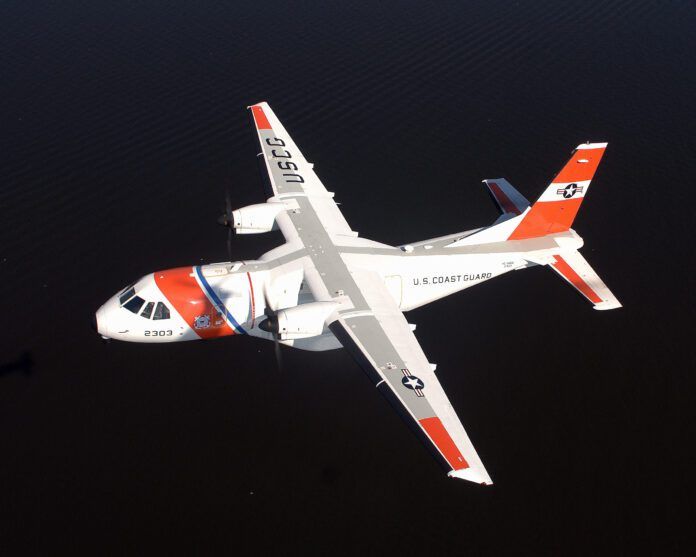I fly a rather obscure aircraft for the Coast Guard: the HC-144, a twin turboprop about the size of a Dash 8. With the Coast Guard call-sign it is also often assumed we are a helicopter, resulting in the following exchanges throughout my time:
While at 15,000 feet, 225 TAS: “What type helicopter is that, a Chinook?”
While on approach:
Approach: “Cessna 123 follow the Coast Guard helicopter. Number two for the runway.”
Us: “Approach, we’re a twin turboprop.”
Approach: “Roger, sorry. Cessna 123, follow the light twin.”
Close enough.
While landing:
Tower: “Coast Guard, cleared direct to the ramp, landing at your own risk.”
Me: “Well, I could maybe do that once but I’d prefer the runway.”
Tower: “Ah, I take it you’re fixed wing!”
LT Nathan Souleret
Coast Guard Air Station Miami, FL



































Clearly the designation “HC” is the issue. How are the C-130s tagged in the CG?
Also, what kind of tower doesn’t have eyes on the aircraft around it?
On ATC scopes and strips the identifier is CN35 – abbreviated Casa 235. There really is no excuse for this being confusing to ATC. Further, the callsigns for this type start with 23 – so C2314 is going to be a CN35. It’s the same story with the H60 – callsigns start with a 60 – so something like C6024 will be an H60.
Neat plane but it makes me sad to see our US military using foreign built aircraft. I know that is hypocritical seeing so many foreign services use planes built in the US but we are or should be the leader with the planes people want.
The US military and USCG have long used foreign built and/or original foreign designed aircraft. There are many reasons for that, not the least of which is what makes the best sense financially. Dealing with defense budget limitations usurps national pride (or just knowing a good piece of hardware is too good to pass up for the mission requirements). A few better-known examples:
US Army: C-7A Caribou (DeHavilland)
USMC: AV-8 Harrier (originally BAE designed A-model, improved B-model built under McDD)
USCG: MH-65 Dolphin helicopter (Eurocopter)
USN: T-45 Goshawk (originally BAE T1 designed Hawk, built under McDD)
USAF: T-6 Texan II (originally designed Pilatus PC-9, built under Textron)
Those are just off the top of my head and there are countless other pieces and parts that have been foreign designed and built and put into our military aircraft over the decades. Perhaps the most well known and most important in history is the Rolls-Royce Merlin engine upgrade over the Allison for the P-51 Mustang.
Having flown in a Dolphin, I can attest that buying the best vehicle for the mission doesn’t apply to Congress, which insisted that the power plant around which the Dolphin was designed, be replaced by a much heavier GE turbine, resulting in a heavy chopper that had to eliminate safety equipment in order to be able to fly. The ergonomic crash seats were replaced by simple metal frames with cloth slings, that were so uncomfortable, they affected crew performance and caused repetitive stress injury.
It was a Lycoming turbine, the LTS-101, IIRC. But, yeah- its reliability was atrocious. Not uncommon at all to hear of them RTB on one engine.
I think they re-engined the fleet with Turbomeca power plants, which worked out pretty well.
The Martin B-57 was a famous example, late variants were the original all-weather interdiction airplane; an Americanized English Electric Canberra. Quite successful in Vietnam.
I’ve heard it the other way as well – New York Center once contacted Air North (ok – I’m dating myself,) in a Twin Otter – we need you to increase your airspeed, and increase your rate of climb – response – which would you like – we can’t do both! – NYCenter – Air North – confirm that you’re not a helicopter.
Back in the early 70’s I was flying a U-10 (Helio Courier STOL) for the Utah Army National Guard. One night I was approaching SLC on about a 15 mile final and decided to play around a little bit with a big head wind. I slowed the plane down and then “hung it on the prop” which resulted in a ground track where it looked like I had reversed course to approach control. The controller ask me my heading and I advised him it remained the same 160. He then asked me what kind of aircraft I was flying. I replied it is a Helio Courier. He said never heard of that kind of helicopter to which I said it’s an airplane. I told him to trade with a local controller and go to the tower. I over flew the runway at about 200 feet until I was adjacent to the tower and the zeroed my forward motion and slowly made a vertical descent to the runway. Sometimes big winds can be fun!
Back in the day my brother would get into trouble and give the authorities my name. Nice brother, right? Another case of mistaken identity…
I fly a BL-26 aka a Bellanca Viking. I was approaching PHL (Philly International) for landing from the Northwest when I was cleared to land on Taxiway Alpha. When I queried, “Confirm that you want me to land on taxiway Alpha?” ( could have easily don it.), I was cleared to land on Ry 26 with an apology, “sorry we thought you were a helicopter”.